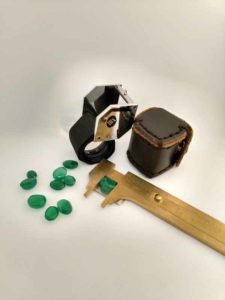
Transparency and texture
Chinese systems of jadeite evaluation measure ‘Zhong,’ or transparency and texture, to grade the quality of gem pieces. (See the second edition of R. Wise’s Secrets of the Gem Trade, published by Brunswick House Press in 2016.) These factors are closely related to the composition of jade stones, which are comprised of different microcrystals with varying degrees of uniformity. The finest specimens are those where these tiny crystals are evenly distributed, creating a smooth and soft look.
Jade transparency ranges from translucent to opaque. Neither jadeite nor nephrite can be fully transparent. However, the most desirable pieces present a high translucency that gives them a glass-like appearance. Jade texture refers to the smoothness and visual texture of the stone’s grain.
Wax coating to improve jade texture is a standard process observed in most A-grade pieces. It is widely accepted and has no impact on value. The main treatment to enhance lower-quality pieces is polymer resin impregnation, which is common practice in Asian markets and very difficult to detect if undisclosed. If unsure, buyers should either request a gemmological report or refer the pieces for further examination.
Cut
Jade is usually cut into cabochons or carved into ornamental pieces. The quality of the cut is measured by the lustre achieved during the polishing process. Fine jadeite specimens can achieve a high glass lustre, which gives them the appearance of being wet and is enhanced by the transparency of fine material. Being softer than jadeite, nephrite jade undergoes less polishing and may present a resin or waxy lustre. Polymer impregnation can alter the polished look of finished pieces.

Clarity
The last quality factor measured in jade is its clarity, which is determined by the absence of visible defects such as spotting, cottony or silky inclusions, and fractures. These characteristics influence the value of more high-quality transparent gems. However, inclusions can increase the value of nephrite if the presence of silk creates chatoyancy, giving rise to the most sought-after cat’s eye jade. Clarity enhancement is usually achieved with the same polymer impregnation process to deal with surface-reaching fractures, which would otherwise compromise the stone’s durability.
As noted previously, nephrite is seldom treated because its microscopic, nonporous, oil- and acid-resistant, ‘fabric-like’ structure rarely allows for dyes or resins. Heat treatments may be used; however, the comparative availability of nephrite over the rarer jadeite does not command manipulation for it to be placed in the market as a valuable gemstone. Its identity is almost always natural. Also, some heat treatments can actually reduce the stability of the mineral, as with tanzanite.
The variables of value
This article offers a brief overview of the five key characteristics of jade consumers consider when purchasing either jadeite or nephrite. As with all gemstones, personal preference and purchasing agenda influence how value is ascribed to jade items. The authors wish to emphasize the fact the jade value chain (JVC) is complex, and that to best understand all the variables influencing industry assessment of jade from mine to retail, a more detailed presentation is required. One such presentation is currently being prepared.
These authors have designed a system that works to penetrate the predominantly clandestine jade business model in Asia for the benefit of global consumers of this ancient gemstone. For more on this system and on valuing jade, watch for a future issue of Jewellery Business.
 Samuel Michael Dilts, B.Sc., is a graduate in molecular medicine from the Australian National University, a sculptor, and an industrial designer. He is the founder of New Sun Jade of Vancouver and BC Jade of Hong Kong. Dilts is the creator of several patented and trademarked jade products designed to advance the sustainability of the jade value chain (JVC) for North American industry professionals. He can be reached via e-mail at sam@newsunjade.com.
Samuel Michael Dilts, B.Sc., is a graduate in molecular medicine from the Australian National University, a sculptor, and an industrial designer. He is the founder of New Sun Jade of Vancouver and BC Jade of Hong Kong. Dilts is the creator of several patented and trademarked jade products designed to advance the sustainability of the jade value chain (JVC) for North American industry professionals. He can be reached via e-mail at sam@newsunjade.com.
 Laura Acosta Vidales, GIA GG, AJP, holds a B.Sc. in economics from Anuhuac University and an M.Sc. in finance from the London School of Business and Finance. She graduated from the Gemological Institute of America (GIA) in 2011, defines herself as a gem enthusiast, and has been studying and collecting gems for as long as she can remember. Currently, Vidales works as an independent gemmologist in Mexico, identifying and appraising pieces. She can be reached via e-mail at lca.vidales@gmail.com.
Laura Acosta Vidales, GIA GG, AJP, holds a B.Sc. in economics from Anuhuac University and an M.Sc. in finance from the London School of Business and Finance. She graduated from the Gemological Institute of America (GIA) in 2011, defines herself as a gem enthusiast, and has been studying and collecting gems for as long as she can remember. Currently, Vidales works as an independent gemmologist in Mexico, identifying and appraising pieces. She can be reached via e-mail at lca.vidales@gmail.com.
 Andrew Loo holds a B.A. from Windsor University as well as a post-graduate degree in geology from Peking University. He is a Fellow of the Gemmological Association of Great Britain (Gem-A) and has been a gemstone educator for nearly two decades, having joined the gemstone laboratories in Hong Kong and Antwerp. Loo currently works as a gemmologist, with a private client base of collectors, jewellery retailers, auction houses, and gemmological associations. He can be reached via e-mail at andrewsyloo@gmail.com.
Andrew Loo holds a B.A. from Windsor University as well as a post-graduate degree in geology from Peking University. He is a Fellow of the Gemmological Association of Great Britain (Gem-A) and has been a gemstone educator for nearly two decades, having joined the gemstone laboratories in Hong Kong and Antwerp. Loo currently works as a gemmologist, with a private client base of collectors, jewellery retailers, auction houses, and gemmological associations. He can be reached via e-mail at andrewsyloo@gmail.com.





